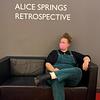You need to sign in or sign up before continuing.
Take a photo of a barcode or cover
This was an interesting historical fiction story set largely in 1940s San Francisco with a light dusting of science fiction. I admit I had trouble keeping all the characters straight (so to speak), and was often confused by the shifting point of view. I liked all the historical details of the city that were included.
Fantastic and heartwarming
Klages' writing always immerses me in the worlds and heads of her characters, and this is no exception. Love, secrets, and magic in a San Francisco that was. Delightful.
Klages' writing always immerses me in the worlds and heads of her characters, and this is no exception. Love, secrets, and magic in a San Francisco that was. Delightful.
dark
sad
tense
medium-paced
Plot or Character Driven:
A mix
Strong character development:
Complicated
Loveable characters:
Complicated
Diverse cast of characters:
Yes
Flaws of characters a main focus:
No
emotional
hopeful
inspiring
reflective
medium-paced
Plot or Character Driven:
Character
Strong character development:
No
Loveable characters:
Yes
Diverse cast of characters:
Yes
Flaws of characters a main focus:
No
Mega bummed about this. The premise of magical lesbians in 1940s San Francisco? A continuation of a great short story (Caligo Lane) by the author? SIGN ME UP. But it was not what was on the tin. Some other review said that it seemed like the author had done a ton of research into the lives of lesbians in SF and wanted to include all of it, in spite of the plot, and that does seem to be the case. But also, it was hard to read about a Japanese woman who is—purportedly—ok with people thinking she's Chinese, and also repeats racial slurs? (and also says, when asked why pretend to be Chinese, "I don't. Well, except at work , but so do half the other performers... Tourists can't tell the difference. To them we're all mysterious Orientals."—which like, Japan entered WWII by the time this was set! There was a lot of racism against Japanese folks in particular! Why wouldn't you mention that as a reason!) I dunno man. Rubbed me the wrong way.
emotional
medium-paced
Plot or Character Driven:
Character
Strong character development:
No
Loveable characters:
Yes
Diverse cast of characters:
Yes
Flaws of characters a main focus:
No
Shoutout to Emily for recommending this-- I loved it so much! YAY for historical fiction stories about queer women! Especially those that have happy endings!
An old woman comes into an antique shop claiming she can sell the last (and until that day presumed lost) painting of a cult artist, a pulp fiction illustrator, from the 1940s. But what is the story of this painting?
The novella takes us back into 1940s San Francisco and tells the story of Haskel, the artist, Helen, a law-graduated-turned-dancer (due to the limited options thanks to racism and sexism), and Emily, who is a new arrival in San Francisco after being kicked out of her boarding school for being queer and falls for Haskel. It is also the story of a couple of other queer women around them who support each other in the face of a society which decidedly does not. Also, there is science and actual magic within the pages of this novella - but while the magical elements were crucial to the story they were less present throughout the entirety of the novella than I had expected.
Ellen Klages draws from typical 1940s genres such as pulps, film noir, and screwball comedies. She combines these elements with a portrayal of queer subculture and solidarity amidst a racist, sexist, and homophobic society. She treads the line of showing violence and still writing an entertaining and surprising tale - for most parts that worked very well for me. I also enjoyed the ways Klages goes into the historical details of the time period the story is (mostly) set in, though sometimes I felt she went a little bit too far really explaining everything to the t. But all in all, I really liked this book and gobbled it down in one evening.
The novella takes us back into 1940s San Francisco and tells the story of Haskel, the artist, Helen, a law-graduated-turned-dancer (due to the limited options thanks to racism and sexism), and Emily, who is a new arrival in San Francisco after being kicked out of her boarding school for being queer and falls for Haskel. It is also the story of a couple of other queer women around them who support each other in the face of a society which decidedly does not. Also, there is science and actual magic within the pages of this novella - but while the magical elements were crucial to the story they were less present throughout the entirety of the novella than I had expected.
Ellen Klages draws from typical 1940s genres such as pulps, film noir, and screwball comedies. She combines these elements with a portrayal of queer subculture and solidarity amidst a racist, sexist, and homophobic society. She treads the line of showing violence and still writing an entertaining and surprising tale - for most parts that worked very well for me. I also enjoyed the ways Klages goes into the historical details of the time period the story is (mostly) set in, though sometimes I felt she went a little bit too far really explaining everything to the t. But all in all, I really liked this book and gobbled it down in one evening.
Very enjoyable. Yet another book where my complaint is that it was too short!
For the most part, this is a look at the queer scene in 1940's San Francisco. It acknowledges the bad, but mostly focuses on the good. Magic is fairly minimal, and for most of the book keeps to the background. The focus is not on the magic, or even the history, but on the characters and their loves, lives, and dilemmas.
One of my favorite bits was when Haskel and Emily were at an "Oriental" club. There were horribly trite and offensive jokes being told from the stage (alongside very classy singing and dancing acts). Their friend Franny (one of the performers) explained that it was what the white clientele wanted, and it beat working anywhere else where ALL an Asian performer could do was perpetuate idiotic stereotypes. This feels very true to life, and I can't help but wonder if there are entertainments still today that fall into "give the white people what they want" just to make a living.
For the most part, this is a look at the queer scene in 1940's San Francisco. It acknowledges the bad, but mostly focuses on the good. Magic is fairly minimal, and for most of the book keeps to the background. The focus is not on the magic, or even the history, but on the characters and their loves, lives, and dilemmas.
One of my favorite bits was when Haskel and Emily were at an "Oriental" club. There were horribly trite and offensive jokes being told from the stage (alongside very classy singing and dancing acts). Their friend Franny (one of the performers) explained that it was what the white clientele wanted, and it beat working anywhere else where ALL an Asian performer could do was perpetuate idiotic stereotypes. This feels very true to life, and I can't help but wonder if there are entertainments still today that fall into "give the white people what they want" just to make a living.






